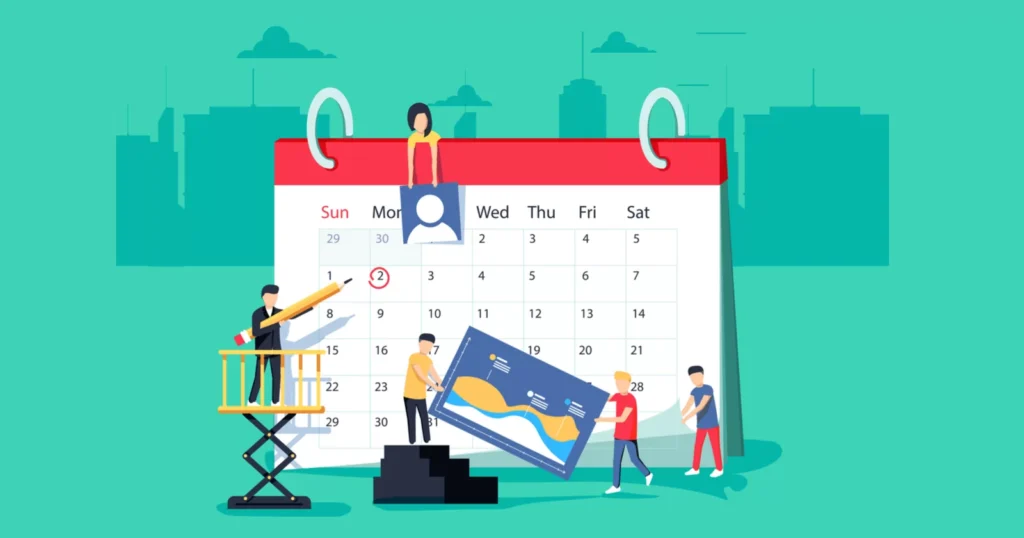Creating a social media content calendar is a powerful tool that helps keep your brand organized while driving engagement with your audience. With a well-planned calendar, you can maintain consistency, track performance, and build stronger relationships with followers. Let’s explore how you can create a content calendar that not only aligns with your goals but also boosts engagement.

1. Know Your Goals
First and foremost, set clear goals. Without goals, your content strategy might lack direction. For instance, do you want to increase brand awareness, drive traffic, or nurture your community? By identifying your goals, you can make sure that your content speaks directly to what you want to achieve.
Additionally, if your main goal is engagement, consider including interactive content such as polls, quizzes, or challenges. These types of posts encourage your audience to participate, which naturally increases engagement.
2. Understand Your Audience
Next, understanding your audience is crucial. If you want to engage your followers effectively, you need to know what interests them. Begin by creating detailed audience personas. These will guide your content and help you address their specific needs, preferences, and concerns.
Furthermore, use analytics tools to gain insights into when your audience is most active. By posting at the right times, you significantly increase the chances that your content will be seen and interacted with.
3. Select Content Types
It’s important to offer variety in your content. Offering the same type of content repeatedly may bore your audience. Therefore, mix it up by using a combination of content types, such as:
- Educational Posts: Share useful tips, how-to guides, or industry news.
- Entertaining Content: Include memes, jokes, or fun facts related to your niche.
- User-Generated Content: Encourage followers to share their experiences with your products.
- Behind-the-Scenes: Show what goes on behind the curtain at your company.
- Polls & Quizzes: Engage your followers with fun or informative polls and quizzes.
By mixing these different types of content, you maintain your audience’s interest and keep them coming back for more.
4. Choose the Right Platforms
Additionally, it’s essential to focus on the right platforms. Every social media platform has its strengths. For example, Instagram is perfect for sharing high-quality visuals, while Twitter is great for quick updates and interactions. TikTok thrives on creative, short-form videos. Thus, choose platforms where your audience is most active, ensuring you get the best results.
Moreover, focusing on a few platforms will allow you to invest more time and effort into creating tailored content, leading to better engagement.
5. Create a Posting Schedule
Consistency is key when it comes to engagement. A posting schedule will help you stay on track. Decide how often you want to post on each platform. For example, you might post once a day on Instagram and three times a week on Facebook.
Moreover, use content calendar tools like Google Calendar, Trello, or scheduling apps like Hootsuite and Buffer. These tools help you plan and automate your posts, saving you time and reducing the chance of forgetting to post.
6. Use Engaging Captions
In addition to visuals, your captions play a crucial role in engagement. Crafting attention-grabbing captions is essential. Ask open-ended questions, share intriguing facts, or incorporate strong calls to action (CTAs) like “Tag a friend who would love this!”
By doing so, you encourage your followers to interact with your posts, starting conversations and driving engagement.
7. Monitor and Adjust
Once your posts are live, it’s time to monitor their performance. Which posts received the most likes, comments, and shares? Analytics tools can provide insights into your content’s performance, helping you identify what worked and what didn’t.
Based on this information, don’t hesitate to adjust your content calendar. Experiment with different content types, posting times, and formats. Doing so will help you refine your strategy and continue to improve engagement over time.
8. Repurpose Content
Lastly, repurposing content is an effective strategy. You don’t need to reinvent the wheel every time you post. For example, you can turn a blog post into an eye-catching infographic or a video into a quote graphic. Repurposing not only saves time but also helps you reach a broader audience.
By doing this, you keep your content fresh and engaging while maximizing the value of each piece.
Conclusion
In conclusion, a well-structured social media content calendar is essential for building consistent engagement. By clearly defining your goals, understanding your audience, and using a variety of content types, you can create a strategy that fuels interaction. Remember, consistency and creativity will always be your allies in growing your brand’s online presence.
Feel free to contact us for a free consultation.

